Elsevier期刊投稿.ppt
- 格式:ppt
- 大小:2.00 MB
- 文档页数:41
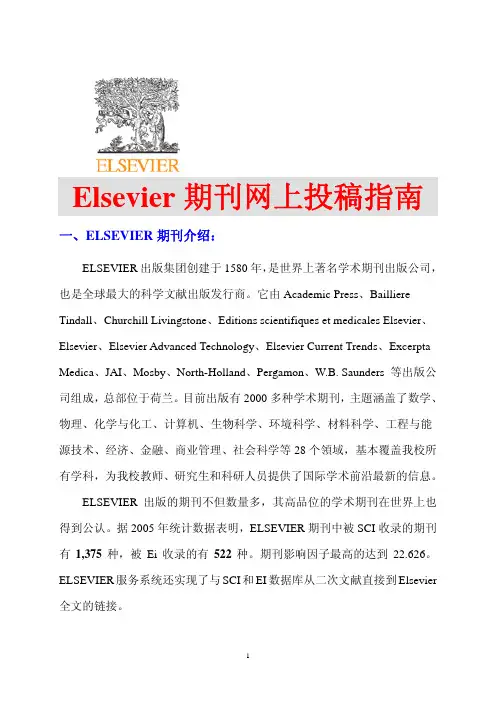
Elsevier期刊网上投稿指南一、ELSEVIER期刊介绍:ELSEVIER出版集团创建于1580年,是世界上著名学术期刊出版公司,也是全球最大的科学文献出版发行商。
它由Academic Press、Bailliere Tindall、Churchill Livingstone、Editions scientifiques et medicales Elsevier、Elsevier、Elsevier Advanced Technology、Elsevier Current Trends、Excerpta Medica、JAI、Mosby、North-Holland、Pergamon、W.B. Saunders 等出版公司组成,总部位于荷兰。
目前出版有2000多种学术期刊,主題涵盖了数学、物理、化学与化工、计算机、生物科学、环境科学、材料科学、工程与能源技术、经济、金融、商业管理、社会科学等28个領域,基本覆盖我校所有学科,为我校教师、研究生和科研人员提供了国际学术前沿最新的信息。
ELSEVIER出版的期刊不但数量多,其高品位的学术期刊在世界上也得到公认。
据2005年统计数据表明,ELSEVIER期刊中被SCI收录的期刊有1,375种,被Ei收录的有522种。
期刊影响因子最高的达到22.626。
ELSEVIER服务系统还实现了与SCI和EI数据库从二次文献直接到Elsevier 全文的链接。
目前,ELSEVIER出版集团在清华大学和上海交通大学图书馆设立镜像服务器,向校园网用户提供电子期刊全文数据库-ScienceDirect OnSite (SDOS)的服务;该站点装载了1995年以来该公司出版的1,774种电子期刊全文数据,文章篇数达2,731,1741篇。
读者也可以访问Elsevier美国主站点—ScienceDirect Online(SDOL)(/)。
SDOS和SDOL数据库均采用校园网范围的IP地址控制使用权限,不需要账号和口令,访问本地镜像和主站点都无需支付国际流量费。
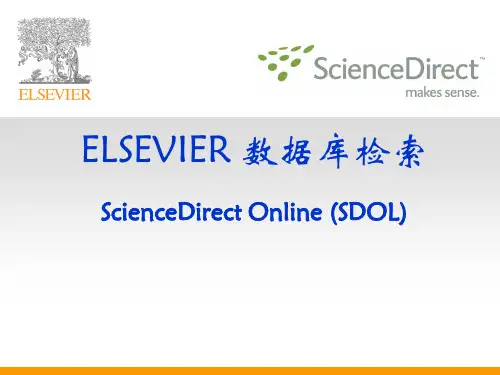


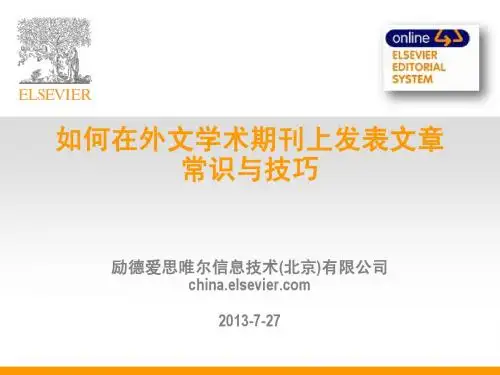
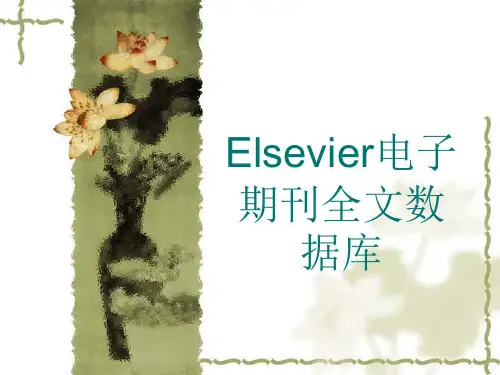
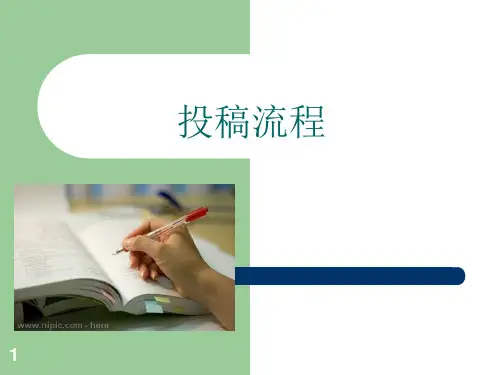
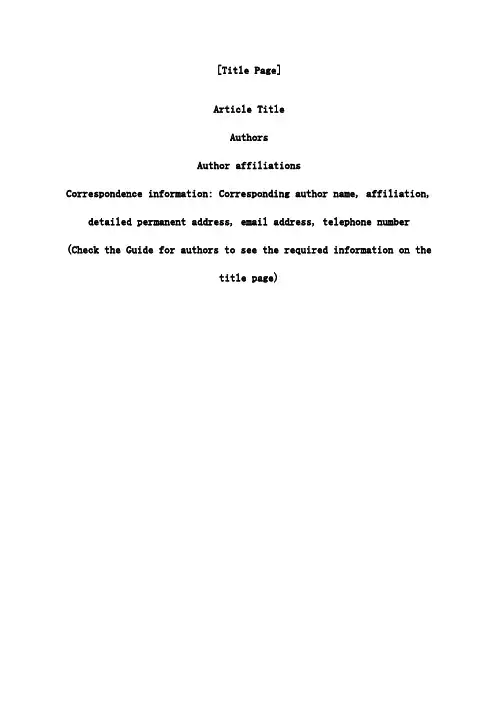
[Title Page]Article TitleAuthorsAuthor affiliationsCorrespondence information: Corresponding author name, affiliation, detailed permanent address, email address, telephone number (Check the Guide for authors to see the required information on thetitle page)Put the title of your abstract here using both upper and lower case letters, Times New Roman, 12?pts, bold, centered, double spacedA.?Author a,B.?Author b,C.?Author a,*a Department, University, Street, Postal-Code City, Countryb Laboratory, Institute, Street, Postal-Code City, Country AbstractThis general template helps you on preparing manuscript for part of Elsevier Journals. Use this document as a template if you are using Microsoft Word 6.0 or later. Here comes self-contained abstract. Please read the Guide for Authors of your target journal for the requirements of Abstract. Pay special attention to the word count.PACS(optional, as per journal):Keywords: Keyword 1.D; Keyword 2.B (Read the Guide for Authors for the requirements for Keywords, including number, thesaurus, and classification indications)* Corresponding author. Tel.: +xx xxx xx xx; fax: +xx xxx xx xx.1. IntroductionThe manuscript should be prepared and submitted according to the Guide for Authors of your target journal. . For your convenience, brief instructions on manuscript preparation are recorded below.Please DO consult a recent journal paper for style and conventions. You may find samples on ScienceDirect. You need to check your manuscript carefully before you submit it. The editor reserves the right to return manuscripts that do not conform to the instructions for manuscript preparation.2. General remarks on manuscript preparationGenerally, double line spacing, 12 pts font, and Times New Roman are preferred when you type the manuscript for review. This text formatting is provided in order to facilitate referee process and is also required for proper calculation of your manuscript length. Typing your manuscript follows the order: Title, Authors, Affiliations, Abstract, Keywords, Main text, Acknowledgements (optional), References (optional), Figure captions, Figures and Tables. Please consult the Guide for Authors for the proper organization of the main text. Ensure that each new paragraph is clearly indicated. Some journals also require lines to be numbered throughout the manuscript. You will usually want to divideyour article into numbered sections and subsections. Present figures and tables at the right places mentioned in the Guide for Authors.Most formatting codes are removed or replaced while processing your article so there is no need for you to use excessive layout styling. Please do not use options such as automatic word breaking, double columns or automatic paragraph numbering (especially for numbered references). Do use bold face, italic, subscripts, superscripts, etc., as appropriate.2.1 IllustrationsMany journals required that figures and tables to be presented on separate pages at the end of the manuscript. The preferable file formats are: EPS (for vector graphics) and TIF (for bitmaps). However, PDF and MS Office (Word, Excel, Powerpoint figures) files are also acceptable. Use file names that enable to identify their contents in terms of figure number and format (e.g. fig1.tif, fig2.eps, fig3.pdf). All artwork has to be numbered according to its sequence in the text. All of them should have captions. Colour figures in printed version require an extra fee for most journals. Generally, no vertical rules (lines) should be used in tables. Illustrations should not duplicate descriptions that appear elsewhere in the manuscript.Please look at for more detailed instructions on artwork preparations.2.2 EquationsConventionally, in mathematical equations variables and anything thatrepresents a value appear in italics. You are encouraged to use equation-editing tools such as mathtype to edit equations. Please make use of the numbering and referencing functions.2.3 CitationsThere are different styles of in-text citations and reference lists. DO consult the Guide for Authors to see the given examples. Pay special attention to the format of author names, journal names, publication year, volume and page span.AcknowledgementsThis section is optional.ReferencesFigure CaptionsFig.1 Put at this page the collected figure captions. The figure captions should be as brief as possible. It should also contain sufficient information that readers do not need to refer to the main text.Fig.2 Put here the figure caption of figure 2 (also the legend to figure 2).Fig. 3Fig.?1. Sample figure. Do not reduce or enlarge any images after placement in an MS Office application as this can lead to loss of image quality. While inserting vector graphics ensure that you use only truetype fonts. These should preferably be in one, or a combination, of the following fonts: Arial, Courier, Helvetica, Symbol, Times.Table 1Sample table: (使用三线表)Parameter Compound 1 Compound 2 a(Å) 4.5832 4.9365Δ E a (eV) 1.745 1.592 ………………a This is an example of a table footnote.。
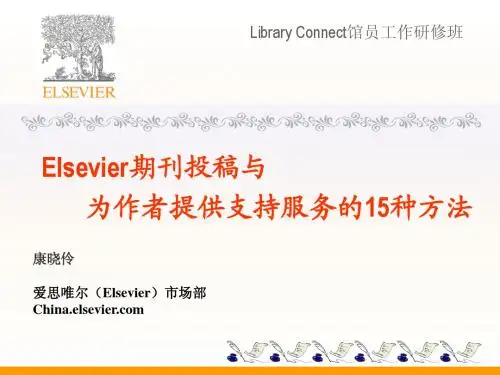
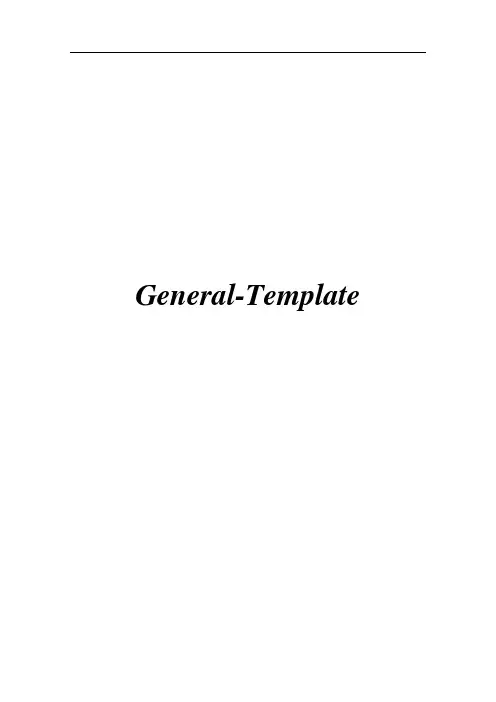
General-Template[Title Page]Article TitleAuthorsAuthor affiliationsCorrespondence information: Corresponding author name, affiliation, detailed permanent address, email address, telephone number(Check the Guide for authors to see the required information on the title page)Put the title of your abstract here using both upper and lower case letters, Times New Roman, 12 pts, bold, centered, double spacedA. Author a,B. Author b,C. Author a,*a Department, University, Street, Postal-Code City, Countryb Laboratory, Institute, Street, Postal-Code City, CountryAbstractThis general template helps you on preparing manuscript for part of Elsevier Journals. Use this document as a template if you are using Microsoft Word 6.0 or later. Here comes self-contained abstract. Please read the Guide for Authors of your target journal for the requirements of Abstract. Pay special attention to the word count.PACS(optional, as per journal): 75.40.-s; 71.20.LPKeywords:Keyword 1.D; Keyword 2.B (Read the Guide for Authors for the requirements for Keywords, including number, thesaurus, and classification indications)* Corresponding author. Tel.: +xx xxx xx xx; fax: +xx xxx xx xx. E-mail address: xxxxx@xxx.xx1. IntroductionThe manuscript should be prepared and submitted according to the Guide for Authors of your taget journal. . For your convenience, brief instructions on manuscript preparation are recorded below.Please DO consult a recent journal paper for style and conventions. You may find samples on ScienceDirect. You need to check your manuscript carefully before you submit it. The editor reserves the right to return manuscripts that do not conform to the instructions for manuscript preparation.2. General remarks on manuscript preparationGenerally, double line spacing, 12 pts font, and Times New Roman are preferred when you type the manuscript for review. This text formatting is provided in order to facilitate referee process and is also required for proper calculation of your manuscript length. Typing your manuscript follows the order: Title, Authors, Affiliations, Abstract, Keywords, Main text, Acknowledgements (optional), References (optional), Figure captions, Figures and Tables. Please consult the Guide for Authors for the proper organization of the main text. Ensure that each new paragraph is clearly indicated. Some journals also require lines to be numbered throughout the manuscript. You will usually want to divide your article into numbered sections and subsections. Present figures and tables at the right places mentioned in the Guide for Authors.Most formatting codes are removed or replaced while processing your article so there is no need for you to use excessive layout styling. Please do not use options suchas automatic word breaking, double columns or automatic paragraph numbering (especially for numbered references). Do use bold face, italic, subscripts, superscripts, etc., as appropriate.2.1 IllustrationsMany journals required that figures and tables to be presented on separate pages at the end of the manuscript. The preferable file formats are: EPS (for vector graphics) and TIF (for bitmaps). However, PDF and MS Office (Word, Excel, Powerpoint figures) files are also acceptable. Use file names that enable to identify their contents in terms of figure number and format (e.g. fig1.tif, fig2.eps, fig3.pdf). All artwork has to be numbered according to its sequence in the text. All of them should have captions. Colour figures in printed version require an extra fee for most journals. Generally, no vertical rules (lines) should be used in tables. Illustrations should not duplicate descriptions that appear elsewhere in the manuscript.Please look at .elsevier./wps/find/authors.authors/authorartworkinstructions for more detailed instructions on artwork preparations.2.2 EquationsConventionally, in mathematical equations variables and anything thatrepresents a value appear in italics. You are encouraged to use equation-editing tools such as mathtype to edit equations. Please make use of the numbering and referencing functions.2.3 CitationsThere are different styles of in-text citations and reference lists. DO consult the Guide for Authors to see the given examples. Pay special attention to the format of author names, journal names, publication year, volume and page span.AcknowledgementsThis section is optional.References[1].[2].Figure CaptionsFig.1 Put at this page the collected figure captions. The figure captions should be as brief as possible. It should also contain sufficient information that readers do not need to refer to the main text.Fig.2 Put here the figure caption of figure 2 (also the legend to figure 2).Fig. 3Fig. 1. Sample figure. Do not reduce or enlarge any images after placement in an MS Office application as this can lead to loss of image quality. While inserting vector graphics ensure that you use only truetype fonts. These should preferably be in one, or a combination, of the following fonts: Arial, Courier, Helvetica, Symbol, Times.Table 1Sample table: (使用三线表)Parameter Compound 1 Compound 2 a (Å) 4.5832 4.9365Δ E a (eV) 1.745 1.592 ………………a This is an example of a table footnote.关于Elsevier旗下期刊投稿1 关于Elsevier旗下期刊投稿概述(1) Elsevier旗下共有1300多种期刊。
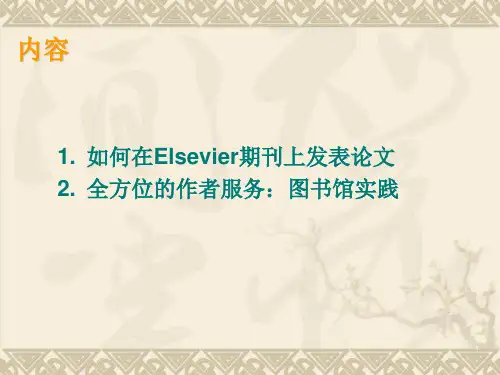
WORD 格式整理版General-Template[Title Page]Article TitleAuthorsAuthor affiliationsCorrespondence information: Corresponding author name, affiliation, detailed permanent address, email address, telephone number(Check the Guide for authors to see the required information on thetitle page)Put the title of your abstract here using both upper and lower caseletters, Times New Roman, 12pts, bold, centered, double spacedA. Author a,B.Author b,C.Author a,*a Department, University, Street, Postal-Code City, Countryb Laboratory, Institute, Street, Postal-Code City, CountryAbstractThis general template helps you on preparing manuscript for part ofElsevier Journals. Use this document as a template if you are usingMicrosoft Word 6.0 or later.Here comes self-contained abstract. Please read the Guide for Authors of your t arget journal for the requirements of Abstract. Pay special attention to the word count.PACS(optional, as per journal):75.40.-s; 71.20.LPKeywords: Keyword 1.D; Keyword 2.B (Read the Guide for Authors for therequirements for Keywords,including number,thesaurus,and classification indications)*Corresponding author. Tel.: +xx xxx xx xx; fax: +xx xxx xx xx. E-mail address: xxxxx@xxx.xx1. IntroductionThe manuscript should be prepared and submitted according to the Guide for Authors of your taget journal. . For your convenience, briefinstructions on manuscript preparation are recorded below.Please DO consult a recent journal paper for style and conventions.You may find samples on ScienceDirect . You need to check your manuscript carefully before you submit it.The editor reserves theright to return manuscripts that do not conform to the instructionsfor manuscript preparation.2. General remarks on manuscript preparationGenerally, double line spacing, 12 pts font, and Times New Roman arepreferred when you type the manuscript for review.This text formatting is provided in order to facilitate referee process and isalso required for proper calculation of your manuscript length. Typingyour manuscript follows the order:Title,Authors,Affiliations,Abstract, Keywords, Main text, Acknowledgements (optional), References(optional),Figure captions,Figures and Tables.Please consult the Guide for Authors for the proper organization of the main text. Ensurethat each new paragraph is clearly indicated.Some journals alsorequire lines to be numbered throughout the manuscript.You will usually want to divide your article into numbered sections and subsections. Present figures and tables at the right places mentionedin the Guide for Authors.Most formatting codes are removed or replaced while processing your article so there is no need for you to use excessive layout styling.Please do not use options such as automatic word breaking, double columns or automatic paragraph numbering(especially for numbered references).Do use bold face,italic,subscripts, superscripts, etc., as appropriate.2.1 IllustrationsMany journals required that figures and tables to be presented on separate pages at the end of the manuscript.The preferable file formats are: EPS (for vector graphics) and TIF (for bitmaps). However,PDF and MS Office(Word,Excel,Powerpoint figures)files are also e file names that enable to identify their contents in terms of figure number and format (e.g. fig1.tif, fig2.eps, fig3.pdf).All artwork has to be numbered according to its sequence in the text.All of them should have captions.Colour figures in printed version require an extra fee for most journals.Generally,no vertical rules(lines)should be used in tables. Illustrations should not duplicatedescriptions that appear elsewhere in the manuscript.Please look at /wps/find/authors.authors/authorartworkinstructions for more detailed instructions on artwork preparations.2.2 EquationsConventionally,in mathematical equations variables and anything thatrepresents a value appear in italics.You are encouraged to use equation-editing tools such as mathtype to edit equations. Please makeuse of the numbering and referencing functions.2.3 CitationsThere are different styles of in-text citations and reference lists.DO consult the Guide for Authors to see the given examples.Payspecial attention to the format of author names, journal names,publication year, volume and page span.AcknowledgementsThis section is optional.References[1].[2].Figure CaptionsFig.1 Put at this page the collected figure captions.The figurecaptions should be as brief as possible.It should also contain sufficient information that readers do not need to refer to the main text.Fig.2 Put here the figure caption of figure 2 (also the legend to figure 2).Fig. 3WORD 格式整理版Fig. 1.Sample figure.Do not reduce or enlarge any images after placement in an MS Office application as this can lead to loss of image quality.While inserting vector graphics ensure that you use only truetype fonts.These should preferably be in one,or a combination, of the following fonts: Arial, Courier, Helvetica, Symbol,Times.WORD 格式整理版Table 1Sample table: (使用三线表 )Parameter Compound 1Compound 2 a ( ? ) 4.5832 4.9365E a (eV) 1.745 1.592⋯⋯⋯⋯⋯⋯a This is an example of a table footnote.关于 Elsevier 旗下期刊投稿 1 关于 Elsevier旗下期刊投稿概述(1)Elsevier旗下共有 1300 多种期刊。